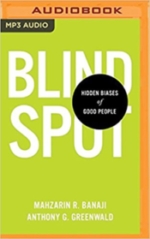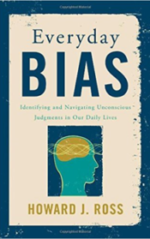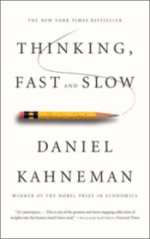Diversity and Inclusion Resources.
Internal Resources
Gender Neutral Bathroom Locations
SPH Creating Gender-Affirming Classroom
Diversity Webinars and Tools
Cook Ross Inc. (DiversityConsulting)
Recommended Reading
Blindspot: Hidden Biases of Good People

“I know my own mind.
I am able to assess others in a fair and accurate way.”
These self-perceptions are challenged by leading psychologists Mahzarin R. Banaji and Anthony G. Greenwald as they explore the hidden biases we all carry from a lifetime of exposure to cultural attitudes about age, gender, race, ethnicity, religion, social class, sexuality, disability status, and nationality.
“Blindspot” is the authors’ metaphor for the portion of the mind that houses hidden biases. Writing with simplicity and verve, Banaji and Greenwald question the extent to which our perceptions of social groups—without our awareness or conscious control—shape our likes and dislikes and our judgments about people’s character, abilities, and potential.
In Blindspot, the authors reveal hidden biases based on their experience with the Implicit Association Test, a method that has revolutionized the way scientists learn about the human mind and that gives us a glimpse into what lies within the metaphoric blindspot.
The book’s “good people” are those of us who strive to align our behavior with our intentions. The aim of Blindspot is to explain the science in plain enough language to help well-intentioned people achieve that alignment. By gaining awareness, we can adapt beliefs and behavior and “outsmart the machine” in our heads so we can be fairer to those around us. Venturing into this book is an invitation to understand our own minds.
Brilliant, authoritative, and utterly accessible, Blindspot is a book that will challenge and change readers for years to come.

The acclaimed social psychologist offers an insider’s look at his research and groundbreaking findings on stereotypes and identity.
Claude M. Steele, who has been called “one of the few great social psychologists,” offers a vivid first-person account of the research that supports his groundbreaking conclusions on stereotypes and identity. He sheds new light on American social phenomena from racial and gender gaps in test scores to the belief in the superior athletic prowess of black men, and lays out a plan for mitigating these “stereotype threats” and reshaping American identities.
 If you are human, you are biased.
If you are human, you are biased.
From this fundamental truth, diversity expert Howard Ross explores the biases we each carry within us. Most people do not see themselves as biased towards people of different races or different genders. And yet in virtually every area of modern life disparities remain. Even in corporate America, which has for the most part embraced the idea of diversity as a mainstream idea, patterns of disparity remain rampant. Why?
Breakthroughs in the cognitive and neurosciences give some idea why our results seem inconsistent with our intentions. Bias is natural to the human mind, a survival mechanism that is fundamental to our identity. And overwhelmingly it is unconscious.
Incorporating anecdotes from today’s headlines alongside case studies from over 30 years as a nationally prominent diversity consultant, Ross help readers understand how unconscious bias impacts our day-to-day lives and particularly our daily work lives. And, he answers the question: “Is there anything we can do about it?” by providing examples of behaviors that the reader can engage in to disengage the impact of their own biases. With an added appendix that includes lessons for handling conflict and bias in the workplace, this book offers an invaluable resource for a broad audience, from individuals seeking to understand and confront their own biases to human resource professionals and business leaders determined to create more bias-conscious organizations in the belief that productivity, personal happiness, and social growth are possible if we first understand the widespread and powerful nature of the biases we don’t realize we have.

In the international bestseller, Thinking, Fast and Slow, Daniel Kahneman, the renowned psychologist and winner of the Nobel Prize in Economics, takes us on a groundbreaking tour of the mind and explains the two systems that drive the way we think. System 1 is fast, intuitive, and emotional; System 2 is slower, more deliberative, and more logical. The impact of overconfidence on corporate strategies, the difficulties of predicting what will make us happy in the future, the profound effect of cognitive biases on everything from playing the stock market to planning our next vacation―each of these can be understood only by knowing how the two systems shape our judgments and decisions.
Engaging the reader in a lively conversation about how we think, Kahneman reveals where we can and cannot trust our intuitions and how we can tap into the benefits of slow thinking. He offers practical and enlightening insights into how choices are made in both our business and our personal lives―and how we can use different techniques to guard against the mental glitches that often get us into trouble. Winner of the National Academy of Sciences Best Book Award and the Los Angeles Times Book Prize and selected by The New York Times Book Review as one of the ten best books of 2011, Thinking, Fast and Slow is destined to be a classic.
Unconscious Bias in Academic Health Sciences
Medical students found to have implicit “anti-fat” bias. Physicians and medical students are less likely to respect obese patients than normal weight patients, and they are more likely to view obese patients negatively.
Miller, D. P., Spangler, J. G., Vitolins, M. Z., Davis, S. W., Ip, E. H., Marion, G. S., & Crandall, S. J. (2013). Are Medical Students Aware of Their Anti-obesity Bias? Academic Medicine, 88(7), 978-982. doi:10.1097/acm.0b013e318294f817
Both women and men rate the quality of men’s work higher than that of women when they are aware of the sex of the person to be evaluated, but not when the same person’s gender is unknown. Department heads were significantly more likely to hire female candidates at the assistant professor level and male candidates at the associate professor level.
Steinpreis, R.E., Anders, K.A., Ritzke, D. (1999). The Impact of Gender on the review of the Curricula Vitae of Job Applicants and Tenure Candidates: A National Empirical Study. Sex Roles, 41(7-8), 509. Doi: 1023/A:1018839203698
In controlled studies, both men and women preferentially select men over women for leadership positions, even when credentials are identical and despite field studies demonstrating women’s equivalent or slightly better leadership effectiveness. The assumption that men will make better leaders than women is attributed to the pervasive existence of unconscious stereotypes that characterize both men and leaders as agentic or action oriented and women as dependent.
Carnes, M., & Bland, C. (2007). Viewpoint: A Challenge to Academic Health Centers and the National Institutes of Health to Prevent Unintended Gender Bias in the Selection of Clinical and Translational Science Award Leaders. Academic Medicine, 82(2), 202-206. doi:10.1097/acm.0b013e31802d939f
Call back rate for job interview of “white” sounding name (9.7%) vs “black” sounding name (6.5%) – 50% difference based on names only.
Bertrand, M., & Mullainathan, S. (2003). Are Emily and Greg More Employable than Lakisha and Jamal? A Field Experiment on Labor Market Discrimination. doi:10.3386/w9873
Black scientist applicants to the NIH, even after controlling for educational background, country of origin, training, previous research awards, publication record, and employer characteristics, are 10 percentage points less likely than whites to be awarded NIH research funding.
Ginther, D. K., Schaffer, W. T., Schnell, J., Masimore, B., Liu, F., Haak, L. L., & Kington, R. (2011). Race, Ethnicity, and NIH Research Awards. Science, 333(6045), 1015-1019. doi:10.1126/science.1196783
Even when physicians report no bias toward black or white patients, their unconscious biases (as measured by the Harvard Implicit Association Test) predict their likelihood of treating thrombolysis based on race (Green, A.R., Carney, D.R., Pallin, D.J. et al., 2007).
Green, A. R., Carney, D. R., Pallin, D. J., Ngo, L. H., Raymond, K. L., Iezzoni, L. I., & Banaji, M. R. (2007). Implicit Bias among Physicians and its Prediction of Thrombolysis Decisions for Black and White Patients. J GEN INTERN MED Journal of General Internal Medicine, 22(9), 1231-1238. doi:10.1007/s11606-007-0258-5
Yale University asked 127 professors to judge identical resumes from a female and male applicant. The participants were significantly more likely to hire the man, pay him a higher salary, and see him as more worthy of mentoring. The bias was equally strong among female and male participants, and did not vary by age, race, or discipline.
Mervis, J. (2012). U.S. Study Shows Unconscious Gender Bias in Academic Science. Science, 337(6102), 1592-1592. doi:10.1126/science.337.6102.1592
Attractive individuals are thought to have better professional lives and stable marital relationships and personalities, according to previous studies. Evidence suggests that the more attractive the applicant is, the greater the chances of being hired.
Kogan, M., Frank, R.M. (2015). A Picture Is Worth a Thousand Words: Unconscious Bias in the Residency Application Process? American Journal of Orthopedics. 44(9), 358-359.
Physicians are not immune to implicit bias. Uncertainty and time pressure surrounding the diagnostic process may promote reliance on stereotypes for efficient decision-making. Physician training emphasizes group level information, like population risk factors, and may expose trainees to minorities in unfavorable circumstances of illness or addiction, reinforcing stereotypes.
Chapman, E. N., Kaatz, A., & Carnes, M. (2013). Physicians and Implicit Bias: How Doctors May Unwittingly Perpetuate Health Care Disparities. J GEN INTERN MED Journal of General Internal Medicine, 28(11), 1504-1510. doi:10.1007/s11606-013-2441-1
Implicit racial attitudes have been proposed as one explanation for the evidence that sometimes clinicians provide worse technical or interpersonal care to nonwhite patients, even when they fully intend to provide equitable care.
Ryn, M. V., & Saha, S. (2011). Exploring Unconscious Bias in Disparities Research and Medical Education. Jama, 306(9). doi:10.1001/jama.2011.1275
Resumés with typically European-American names received 50% more call-backs than those with typically African-American names, and average skilled, typically European-American named candidates received more callbacks than highly skilled typically African-American named candidates.
Hassouneh, D. (2013). Unconscious Racist Bias: Barrier to a Diverse Nursing Faculty. Journal of Nursing Education J Nurs Educ, 52(4), 183-184. doi:10.3928/01484834-20130322-10
Assistant professors on tenure and nontenure tracks are less likely to be promoted than white faculty. Similarly, among assistant professors who received NIH awards and assistant professors who did receive such support, API and URM faculty were less likely to be promoted than white faculty.
Fang, D. (2000). Racial and Ethnic Disparities in Faculty Promotion in Academic Medicine. Jama, 284(9), 1085. doi:10.1001/jama.284.9.1085